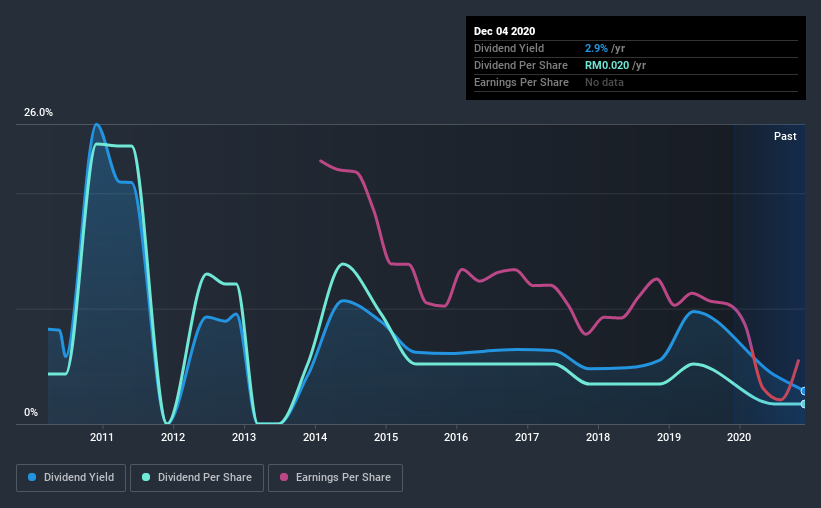- Malaysia
- /
- Auto Components
- /
- KLSE:SAPIND
Should You Buy Sapura Industrial Berhad (KLSE:SAPIND) For Its 2.9% Dividend?
Is Sapura Industrial Berhad (KLSE:SAPIND) a good dividend stock? How can we tell? Dividend paying companies with growing earnings can be highly rewarding in the long term. If you are hoping to live on the income from dividends, it's important to be a lot more stringent with your investments than the average punter.
A slim 2.9% yield is hard to get excited about, but the long payment history is respectable. At the right price, or with strong growth opportunities, Sapura Industrial Berhad could have potential. That said, the recent jump in the share price will make Sapura Industrial Berhad's dividend yield look smaller, even though the company prospects could be improving. When buying stocks for their dividends, you should always run through the checks below, to see if the dividend looks sustainable.
Click the interactive chart for our full dividend analysis

Payout ratios
Companies (usually) pay dividends out of their earnings. If a company is paying more than it earns, the dividend might have to be cut. Comparing dividend payments to a company's net profit after tax is a simple way of reality-checking whether a dividend is sustainable. Although it reported a loss over the past 12 months, Sapura Industrial Berhad currently pays a dividend. When a company is loss-making, we next need to check to see if its cash flows can support the dividend.
Sapura Industrial Berhad paid out 18% of its free cash flow as dividends last year, which is conservative and suggests the dividend is sustainable.
Remember, you can always get a snapshot of Sapura Industrial Berhad's latest financial position, by checking our visualisation of its financial health.
Dividend Volatility
From the perspective of an income investor who wants to earn dividends for many years, there is not much point buying a stock if its dividend is regularly cut or is not reliable. Sapura Industrial Berhad has been paying dividends for a long time, but for the purpose of this analysis, we only examine the past 10 years of payments. Its dividend payments have declined on at least one occasion over the past 10 years. During the past 10-year period, the first annual payment was RM0.05 in 2010, compared to RM0.02 last year. The dividend has shrunk at around 8.8% a year during that period. Sapura Industrial Berhad's dividend hasn't shrunk linearly at 8.8% per annum, but the CAGR is a useful estimate of the historical rate of change.
We struggle to make a case for buying Sapura Industrial Berhad for its dividend, given that payments have shrunk over the past 10 years.
Dividend Growth Potential
Given that dividend payments have been shrinking like a glacier in a warming world, we need to check if there are some bright spots on the horizon. Sapura Industrial Berhad's EPS have fallen by approximately 33% per year during the past five years. A sharp decline in earnings per share is not great from from a dividend perspective, as even conservative payout ratios can come under pressure if earnings fall far enough.
Conclusion
To summarise, shareholders should always check that Sapura Industrial Berhad's dividends are affordable, that its dividend payments are relatively stable, and that it has decent prospects for growing its earnings and dividend. We're not keen on the fact that Sapura Industrial Berhad paid dividends despite reporting a loss over the past year, although fortunately its dividend was covered by cash flow. Earnings per share have been falling, and the company has cut its dividend at least once in the past. From a dividend perspective, this is a cause for concern. Overall, Sapura Industrial Berhad falls short in several key areas here. Unless the investor has strong grounds for an alternative conclusion, we find it hard to get interested in a dividend stock with these characteristics.
Companies possessing a stable dividend policy will likely enjoy greater investor interest than those suffering from a more inconsistent approach. Meanwhile, despite the importance of dividend payments, they are not the only factors our readers should know when assessing a company. Case in point: We've spotted 4 warning signs for Sapura Industrial Berhad (of which 1 is a bit unpleasant!) you should know about.
We have also put together a list of global stocks with a market capitalisation above $1bn and yielding more 3%.
If you decide to trade Sapura Industrial Berhad, use the lowest-cost* platform that is rated #1 Overall by Barron’s, Interactive Brokers. Trade stocks, options, futures, forex, bonds and funds on 135 markets, all from a single integrated account. Promoted
New: Manage All Your Stock Portfolios in One Place
We've created the ultimate portfolio companion for stock investors, and it's free.
• Connect an unlimited number of Portfolios and see your total in one currency
• Be alerted to new Warning Signs or Risks via email or mobile
• Track the Fair Value of your stocks
This article by Simply Wall St is general in nature. It does not constitute a recommendation to buy or sell any stock, and does not take account of your objectives, or your financial situation. We aim to bring you long-term focused analysis driven by fundamental data. Note that our analysis may not factor in the latest price-sensitive company announcements or qualitative material. Simply Wall St has no position in any stocks mentioned.
*Interactive Brokers Rated Lowest Cost Broker by StockBrokers.com Annual Online Review 2020
Have feedback on this article? Concerned about the content? Get in touch with us directly. Alternatively, email editorial-team@simplywallst.com.
About KLSE:SAPIND
Sapura Industrial Berhad
An investment holding company, manufactures, supplies, and sells products for automotive, electronics, and electrical industries in Malaysia.
Excellent balance sheet with proven track record.
Market Insights
Community Narratives





